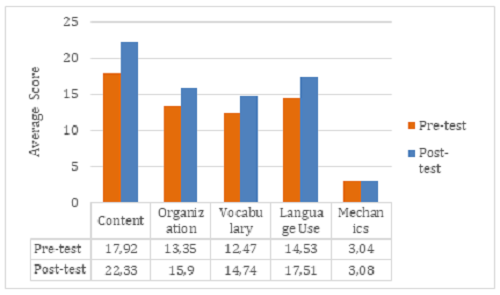
The Effect of Using Video in Flipped Classroom Type on the Ability of SMAN 1 Bangkinang Students in Writing Recount Texts
Abstract
Keywords
Full Text:
PDFReferences
Ahmed, M. A. E. A. S. (2016). The Effect of a Flipping Classroom on Writing Skill in English as a Foreign Language and Students’ Attitude Towards Flipping. 14(2), 98–114.
Auriana, H., Nuraida, I., & Oktaviana, F. (2021). The Influence Of Youtube Based Video Toward Students’ Writing Skill In Recount Text (The Quasi Experimental Research At Tenth Grade Of Smk Daruttaibin. Journal of English Language Teaching and Literature, 4(2)
Belt, E. S., & Lowenthal, P. R. (2021). Video Use In Online And Blended Courses: A Qualitative Synthesis. Distance Education, 42(3), 410–440.
Bergmann, J., & Sams, A. (2012). Flip Your Classroom : Reach Every Student In Every Class Every Day (1st ed.). International Society for Technology in Education.
Best, J. W., & Kahn, J. V. (1998). Research in Education (8th ed.). Allyn and Bacon.
Defaizo, J., Jones, J., Tennant, F., & Hook, A. S. (2010). Academic Literacy: The Importance and Impact of Writing Across the Curriculum – a Case Study. Journal of the Scholarship.
Gudex, C. (2022). The Flipped Classroom: A New Perspective. Medical Writing . 31(3) 80–82). European Medical Writers Association.
Harmer, J. (2004). How to Teach Writing. Pearson Education, Inc.
Heaton, J. B. (1990). Writing English Language Tests. Longman Inc.
Hermawan, I. (2019). Metodologi Penelitian Pendidikan Kualitatif, Kuantitatif dan Mixed Method (1st ed.). Hidayatul Quran Kuningan.
JIAO Li-xia. (2022). The Application of Flipped Classroom Teaching Model in English Writing Course in Educational Informatization 2.0 Background. Sino-US English Teaching, 19(4).
Kong, S. C. (2014). Developing Information Literacy And Critical Thinking Skills Through Domain Knowledge Learning In Digital Classrooms: An Experience Of Practicing Flipped Classroom Strategy. Computers & Education, 78, 160–173.
Kothari, C. R. (2004). Research Methodology (2nd ed.). New Age International Publishers.
Leis, A., Cooke, S., & Tohei, A. (2017). The Effects of Flipped Classrooms on English Composition Writing in an EFL Environment (pp. 1272–1287). IGI Global.
Palazón-Herrera, J., & Soria-Vílchez, A. (2021). Students’ Perception And Academic Performance In A Flipped Classroom Model within Early Childhood Education Degree. Heliyon. 7(4). Elsevier Ltd. https://doi.org/10.1016/j.heliyon.2021.e06702
Rahim, S., & Wahi, W. (2023). Improving Low Proficiency ESL Primary School Students’ Writing Skills using Flipped Classroom. International Journal of Social Science And Human Research, 06(04).
Rotellar, C., & Cain, J. (2016). Research, Perspectives, And Recommendations On Implementing The Flipped Classroom. American Journal of Pharmaceutical Education, 80(2), 1–9.
Sarani, A., Zarei, M. J., & Navidinia, H. (2020). Effect of Online Flipped Classroom on Students’ Writing Development at Senior High School. Journal of English Language. 12(26), 495–515.
Sembiring, D. A. K. (2021). Daring Melalui Metode Pembelajaran Blended Learning-Flipped Classroom. Jurnal Pengelolaan Pendidikan Desember, 2(2), 61–71.
Sengul, F., & Bensen Bostanci, H. (2021). In-Class versus Out-of-Class Flipped Classroom Models in English as a Foreign Language Writing. Propósitos y Representaciones, 9(SPE1).
Silalahi, D. E., R Sihombing, P. S., & Purba, L. (2021). High Order Thinking Skill (Hots) Questions On Learners’ Writing Ability Of Report Text At Efl Of Fkip Universitas Hkbp Nommensen 14(2).
Tarisman, & Hanafi, H. (2020). The Effect of Whatsapp in A Flipped Classroom on Students’ Writing Achievement at MTsN 1 Konawe. Advances, Social Sciences Research Journal, 6(12), 253–268.
Umutlu, D., & Akpinar, Y. (2020). Effects of Different Video Modalities On Writing Achievement In Flipped English Classes. Contemporary Educational Technology, 12(2), 1–16.
Warnock, J. (1983). The Writing Process. Rhetoric Review, 2(1), 4–27.
Whatley, J., & Ahmad, A. (2007). Using Video to Record Summary Lectures to Aid Students’ Revision. Interdisciplinary Journal of E-Skills and Lifelong Learning, 3, 185–196.
Yu, Z., & Gao, M. (2022). Effects of Video Length on a Flipped English Classroom. Sage Open, 12(1).
DOI: http://dx.doi.org/10.31258/jes.7.4.p.561-573
Refbacks
- There are currently no refbacks.
Copyright (c) 2023 Sukma Sekar Ayu, Rumiri Aruan, M Syarfi

This work is licensed under a Creative Commons Attribution 4.0 International License.
Publisher: FKIP Universitas Riau












